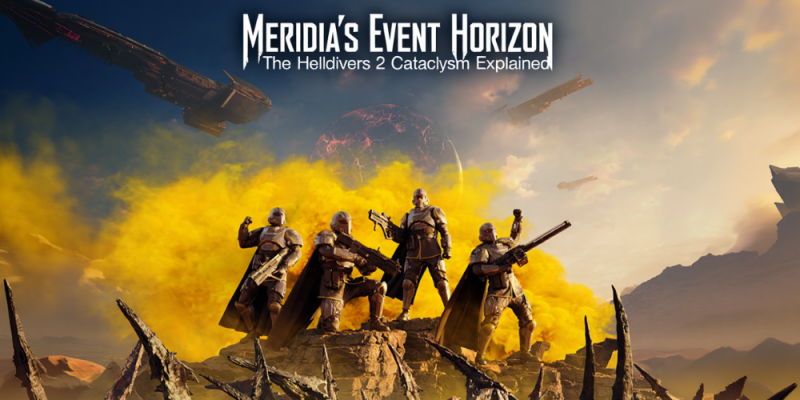Meridia’s Event Horizon: The Helldivers 2 Cataclysm Explained
2025-10-06

Meridia used to be a line on a star map you flew past without thinking, a dust-choked rock where Terminid chitin glistened under sulfur skies. Then Super Earth signed off on an operation so audacious that it changed the skybox for everyone. Under the banner of enlightened liberty, strike teams were ordered to escort canisters of so-called dark fluid into seething rifts that split the planet’s crust. The brief was simple: collapse the supercolony, end an exponential breeding curve, and make the sector safe for convoys again. What followed didn’t just remove a hotspot; it rewrote the local physics. The world flickered off the charts, replaced by a gravitational wound that hums on scanners and drowns out comms. Navigational beacons now flag the coordinate with hazard glyphs. Dispatches insist the situation is contained, yet pilots whisper about lensing arcs and melted relays. Even the cartography overlays feel haunted; zooming the sector renders a glossy whirl where a continent once sat, and the starfield bends like glass under stress. If you stood on a frigate’s observation deck before and after the event, you’d swear the light itself learned a new language. Even mission control UI now overlays a soft red halo there, as if the system itself is reminding us that some victories write their own caution tape.
Main Part
The chain of events traces back to lab memos about an exotic condensate nicknamed dark fluid, a substance that devours heat and momentum while amplifying gravity’s hand. Officially it was a triumph of reverse-engineering and industrial courage; unofficially, the origin story keeps changing, with some memos attributing breakthroughs to captured Automaton cores and others to salvaged artifacts that don’t match either faction’s manufacturing. On Meridia, squads guided bulk containers toward geologic throats mapped by seismic drones. Engineers talked about tapping mantle plumes and turning fault networks into pipelines, so the condensate could seep deep enough to upset planetary equilibrium. As dropships cycled in and out through ash squalls, cities of resin and spore collapsed into their own footprints. The final sorties ferried timing arrays and field stabilizers, then scrambled for orbit while tremors climbed the Modified Mercalli scale and the horizon curved. From the bridge, the world seemed to inhale in eerie silence before the spectrum erupted. Archivists later noted that the planet’s magnetic field fluttered like a torn flag long before the crust gave way, a preamble nobody recognized in time.
What we see now is not a dead rock; it’s an ongoing phenomenon. The coordinate where Meridia hung is dominated by a compact mass wrapped in a shimmering accretion veil, its silhouette rimmed by relativistic glare. Star charts tag it with proximity interdictions, and even hardened corvettes throttle long before the risk envelope. Probes register tidal gradients that can twist hulls and smear telemetry into meaningless rain. A few patrols that tried to skim the edge for heroic snapshots came back scorched, and at least one flotilla simply stopped pinging. Logistics has redrawn convoy lanes to arc around the anomaly, costing hours on every jump. If you drop the sector view to minimal UI, you can watch nearby dust rings stretch into filaments that spool inward like thread. Whether you call it a micro-singularity, a deformed core, or a manufactured sink, the effect is the same: Meridia has become a gravity engine that refuses to cool down or drift into myth. Listening posts have started cataloging chirps and drifts that repeat on eleven-minute cycles, small tells that make physicists lean close to their screens.
Theories breed faster than spores, and some are more than late-night coping. A thread running through intercepted science traffic hints the condensate wasn’t purely ours. Energy signatures near the anomaly match patterns last cited in archived reports on the elusive third power that vanished after the first war. That would explain why Automaton scouts started prowling the perimeter with unusual persistence, and why propaganda reels pivoted from triumph to dignified silence overnight. There’s also the possibility that the sink is doing more than digesting mass; it may be modulating signals, imprinting a rhythm that repeats across subspace like a lighthouse. If that’s true, Meridia isn’t just an end; it’s an announcement, and someone out there may be listening. Narrative designers rarely get to manipulate a galaxy map in real time, but this beat has consequence: strategic chokepoints move, defense budgets tilt toward anti-anomaly research, and every distress call near the vortex carries extra weight. It is no accident that recruiting ads now feature research vessels parked beside destroyers; the frontier has become a laboratory, and every sortie gathers samples as much as glory.
Conclusion
So what should a conscientious Helldiver watch for while command plays the long game? First, monitor priority transmissions from the Ministry of Science; when their tone shifts from celebratory to clinical, new field gear or stratagems usually follow. Second, trace Automaton push patterns; if they begin to converge on the Meridian Rift, expect interdiction assignments that look routine but mask data-gathering aims. Third, pay attention to environmental briefings: unusual radiation, compass drift, or gravitic shear implies the anomaly is flexing again, and extraction windows will narrow. On the human side, keep your squad talking. Moments like Meridia pull at morale because they challenge the simple arc of heroism. That’s fine; let the question live, then do the work in front of you with clarity and restraint. If Meridia taught us anything, it’s that victory can arrive with an aftertaste. The map has a scar now, and in its curve we can read both a warning and the outline of what comes next. Stay nimble with loadouts, keep an eye on patch notes that hide narrative breadcrumbs, and remember that expert citizenship includes curiosity about cause and effect.




